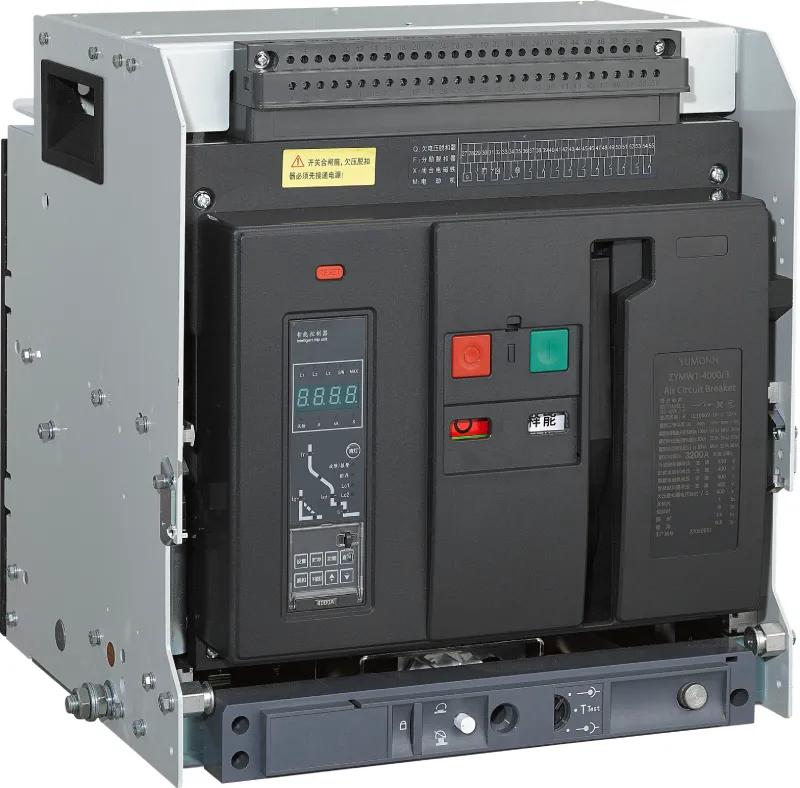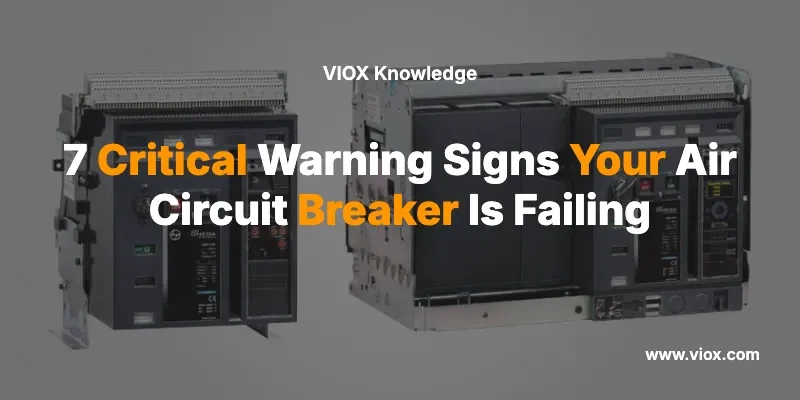A légmegszakítók (ACB-k) az ipari elektromos rendszerek elfeledett hősei, amelyek dollármilliók értékű berendezéseket védenek csendben. De amikor ezek a kritikus alkatrészek meghibásodni kezdenek, a figyelmeztető jelek észrevétlenek lehetnek – amíg meg nem szűnnek. Ha megérti, hogyan azonosítsa a légmegszakító meghibásodásának jeleit időben, megmentheti létesítményét a katasztrofális meghibásodásoktól, a költséges állásidőtől és a biztonsági kockázatoktól.
A légmegszakítók közel 20%-nyi energiaelosztó rendszer meghibásodásának okozói. Ez főként a karbantartás hiányának, pornak, megkeményedett zsírnak, korróziónak vagy befagyott alkatrészeknek tudható be, amelyek megakadályozzák a megszakító megfelelő működését. A kulcs az, hogy tudjuk, mire kell figyelni, mielőtt a kisebb problémák komolyabbá válnának.
Mi teszi a légmegszakító meghibásodásának észlelését olyan kritikussá?

Légmegszakítók igényes ipari környezetben működnek, ahol pornak, hőmérséklet-ingadozásoknak, mechanikai igénybevételnek és elektromos terheléseknek vannak kitéve, amelyek fokozatosan ronthatják a teljesítményüket. Az ACB-k fenntartják a működést és a létesítmények biztonságát azáltal, hogy megszakítják az elektromos áram áramlását hiba esetén, de védelmi képességük teljes mértékben a mechanikai és elektromos integritásuktól függ.
A kisebb lakossági megszakítókkal ellentétben az ipari AC-k több száz vagy több ezer amperes áramköröket vezérelnek. Meghibásodásuk következményei messze túlmutatnak egy egyszerű áramkimaradáson – potenciális berendezéskárosodással, termelésleállásokkal és biztonsági kockázatokkal járhatnak, amelyek a teljes működésre kihathatnak.
A 7 legkritikusabb légmegszakító meghibásodási jele
1. Gyakori vagy megmagyarázhatatlan kioldások
A légmegszakító problémáinak legnyilvánvalóbb jele a gyakori, látható ok nélküli kioldás. A nem baleseti kioldás rövidzárlat és túlterhelés nélküli kioldást jelent. Ha a légmegszakító normál terhelési körülmények között ismételten kiold, az belső alkatrész-károsodásra utal.
Mit kell ellenőrizni:
- Kioldóegység kalibrálása és beállításai
- Működtető mechanizmus beállítása
- Érintkező kopás és rugófeszültség
- Vezérlő áramkör integritása
Azonnali intézkedés: Dokumentálja a kioldási mintákat és a terhelési körülményeket a kioldások bekövetkeztekor. Ezek az adatok segítenek a karbantartó csapatoknak azonosítani, hogy a probléma magában a megszakítóban vagy külső tényezőkben rejlik-e.
2. Bezárás vagy zárva maradás elmulasztása
Sok oka lehet annak, hogy a légmegszakító miért nem zárható be. Ha a légmegszakító nem zár megbízhatóan, vagy nem nyit azonnal a zárás után, az komoly mechanikai vagy elektromos problémákat jelez a működtető mechanizmusban.
Gyakori mögöttes okok:
- Energiatároló rugó meghibásodása: Záráskor a légmegszakító négykaros mechanizmusa nem tud a holtpontig nyomni, és a mechanizmus nem tud magától zárt helyzetben maradni.
- Beragadt működési mechanizmus: Idegen törmelék vagy kenés hiánya a mozgó alkatrészekben
- Alacsony feszültségű kioldási problémák: A túl alacsony feszültség vagy az alulfeszültség-kioldó tekercs áramkimaradása szintén kioldja a levegő-megszakítót, és nem lehet újra bekapcsolni.
- Kopott kioldómechanizmus alkatrészek
3. Látható fizikai sérülések és túlmelegedés jelei
A fizikai ellenőrzés gyakran feltárja a légmegszakító meghibásodásának legjelesebb jeleit. Keresse ezeket a kritikus figyelmeztető jelzéseket:
Túlmelegedés tünetei:
- Elszíneződés a csatlakozók és csatlakozók körül
- A megégett foltok túlmelegedést jeleznek, ami komoly tűzveszélyt jelent.
- Megégett vagy megolvadt szigetelőanyagok
- Szokatlan hőtermelés normál működés közben
Mechanikai sérülésjelzők:
- Repedt vagy sérült ívcsúszdák
- Korrodált vagy kilyukadt érintkezők
- Laza rögzítőelemek
- Olaj- vagy zsírszivárgás a működtető mechanizmusokból
4. Rendellenes hangok működés közben
A füled képes észlelni a légmegszakító problémáit, mielőtt a vizuális ellenőrzés feltárná azokat. A légmegszakító normál működése következetes, kiszámítható hangokat ad ki a nyitási és zárási ciklusok során.
Figyelmeztető hangok, amelyeket érdemes megvizsgálni:
- Csiszoló vagy kaparó hangok működés közben
- Szokatlan kattogás vagy csattanás
- Zúgás vagy búgás a vezérlő áramkörökből
- Csend, amikor a megszakítónak működnie kellene
A zümmögő hangok azonnali beavatkozást igénylő vezetékezési problémákra vagy túlterhelésre utalhatnak. A zümmögő hangok a kioldótekerccsel, laza csatlakozókkal vagy a megszakítón belüli hibás álló érintkezőkkel kapcsolatos problémákra is utalhatnak.
5. Vezérlőáramkör és segédérintkező problémák
A modern légkondicionáló megszakítók (ACC-k) nagymértékben támaszkodnak a vezérlőáramkörökre a távműködtetéshez és az állapotjelzéshez. A hibásan működő vezérlőáramkörök gyakran korai jelzést adnak a légkondicionáló megszakítók szélesebb körű problémáiról.
Vezérlőkör figyelmeztető jelzései:
- Inkonzisztens pozíciójelzés
- Távoli műveleti parancsok nem hajtódnak végre
- Segédérintkezők helytelen állapotjeleket adnak
- Szabályozza az energiafogyasztást a normál paramétereken kívül
Vizsgálati prioritások:
- A rossz érintkezők, mint például a zárógombok, reléérintkezők, megszakítók segédérintkezői stb., valamint a sérült alkatrészek az áramkör elakadásához és a kioldótekercsek áramkimaradásához vezethetnek.
- Ellenőrizze a vezérlőfeszültség szintjeit és stabilitását
- Segédérintkező működésének és beállításának tesztelése
6. Érintkező lebomlása és az ívcsúszda problémái
A primer érintkezők és az ívcsatornák viselik a villamos terhelés legnagyobb részét normál üzem és hiba esetén. Állapotuk közvetlenül befolyásolja az ACP megbízhatóságát és biztonságát.
Érintkező állapotfelmérése:
- Ha a fő érintkezőkön (dinamikus és statikus érintkezők) lévő ezüstötvözet érintkezőréteg vastagsága elektromos kopás miatt kevesebb, mint 1 mm, akkor azt ki kell cserélni.
- Érintkezőillesztés és rugóerő-ellenőrzés
- Felületi állapot és gödrösödés értékelése
Ívcsúszda ellenőrzési pontjai:
- Ezután ellenőrizni kell az ívcsúszdákat, hogy nincs-e bennük szennyeződés vagy nedvesség. Az ívcsúszdák bordáin előfordulhat némi fekete elszíneződés, ami normális és elfogadható, amíg nem sérültek.
- Megfelelő elhelyezés és rögzítés
- Deion lemez állapota és tisztasága
7. Szigetelés romlása
A légmegszakítók szigetelési teljesítménye hosszú távú használat után fokozatosan romlik. Ha a szokásos körülmények között nem megfelelő karbantartást végeznek, a szigetelő alkatrészek felületén felhalmozódó por és a nedvesség okozta erózió felgyorsítja a szigetelés öregedését, ami rövidzárlatot okozhat a fázisok vagy a relatív föld között.
Szigetelésvizsgálati módszerek:
- Szennyeződés és sérülés vizuális ellenőrzése
- Szigetelési ellenállás vizsgálata
- Átütési szilárdság ellenőrzése
- Környezeti tényezők értékelése (páratartalom, hőmérséklet, szennyeződés)
Mikor kell azonnal cselekedni
Bizonyos légmegszakító meghibásodási jelei azonnali figyelmet igényelnek a biztonsági veszélyek vagy a berendezés károsodásának megelőzése érdekében:
Azonnali leállítást igénylő vészhelyzetek:
- Bármilyen látható ív vagy szikra
- Füst vagy égett szagok
- A forró áramkör-megszakító jelentős piros jelzés.
- Teljes működésképtelenség parancs hatására
- Belső alkatrész meghibásodásának bizonyítéka
Sürgős, de nem vészhelyzeti esetek:
- Gyakori kellemetlen kioldások
- Inkonzisztens működési időzítés
- Apróbb vezérlőáramköri problémák
- Korai stádiumú kontakt kopás
Megelőző karbantartás: Az első védelmi vonal
A légmegszakítók meghibásodásának megelőzésére a leghatékonyabb megközelítés a rendszeres ellenőrzési ütemtervek és az állapotalapú felügyelet kombinációja. A nagyfeszültségű megszakítókat 6-12 havonta, míg a középfeszültségű megszakítókat évente vagy 2000 működés után karban kell tartani.
Alapvető karbantartási tevékenységek:
- Kapcsolatfelvételi ellenőrzés és karbantartás: Minden rövidzárlati áramkimaradás után a légmegszakítót az alábbiak szerint kell ellenőrizni: (1) A fő- és ívérintkezőkön lévő füstnyomokat alkohollal le kell törölni. (2) Ha apró fémrészecskék képződnek az érintkező felületén, azokat meg kell tisztítani és le kell simítani.
- Működtető mechanizmus kenése és beállítása
- Vezérlőáramkör tesztelése és kalibrálása
- Szigetelés tisztítása és tesztelése
- Kioldóegység funkcionális ellenőrzése
Fejlett diagnosztikai technikák
A modern létesítmények egyre inkább a prediktív karbantartási technológiákra támaszkodnak, hogy a légmegszakítókkal kapcsolatos problémákat még azelőtt észleljék, mielőtt azok meghibásodást okoznának:
Állapotfelügyeleti eszközök:
- A hőkamerás képalkotás, más néven infravörös termográfia, egy roncsolásmentes vizsgálati módszer az elektromos eszközök rendellenességeinek kimutatására.
- Rezgéselemzés a mechanikai alkatrészek értékeléséhez
- Érintkezési ellenállás mérése
- Részleges kisüléses vizsgálat a szigetelés értékeléséhez
A figyelmeztető jelek figyelmen kívül hagyásának költsége
A légmegszakító meghibásodására utaló jelek megjelenésekor a beavatkozás késlekedése súlyos következményekkel járhat. Valós helyzetekben ezen jelek figyelmen kívül hagyásának következményei súlyosak lehetnek. Például egy fémfeldolgozó üzemben egy légkompresszor vezérlésének meghibásodása miatt tűz ütött ki, ami az energiainfrastruktúra átfogó felújítását tette szükségessé.
Pénzügyi hatásokkal kapcsolatos megfontolások:
- Sürgősségi javítási költségek vs. tervezett karbantartási költségek
- Termelési leállás és bevételkiesés
- Másodlagos berendezések károsodása elektromos hibák miatt
- Biztonsági események költségei és szabályozási vonatkozásai
Proaktív ACB-kezelési program kiépítése
Egy hatékony légmegszakító megbízhatósági program létrehozása strukturált megközelítést igényel, amely ötvözi a rendszeres ellenőrzéseket, az állapotfelügyeletet és a karbantartási tervezést:
Programösszetevők:
- Alapfelmérés az összes ACB-ről az Ön létesítményében
- Kockázatalapú karbantartási ütemezés kritikusság és állapot alapján
- Képzési programok üzemeltetési és karbantartó személyzet számára
- Dokumentációs rendszerek a teljesítmény és a karbantartási előzmények nyomon követéséhez
- Vészhelyzeti reagálási eljárások ACB hibák esetén
Következtetés: A korai felismerés mindent megment
A légmegszakító meghibásodási jeleinek korai felismerése megvédi létesítményét az elektromos rendszer meghibásodásainak kaszkádhatásaitól. Az itt ismertetett hét figyelmeztető jel – gyakori kioldás, zárási hibák, fizikai sérülések, rendellenes hangok, vezérlőáramköri problémák, érintkezőkárosodás és szigetelési problémák – átfogó keretet biztosít a légmegszakító állapotfelméréséhez.
Ne feledje, hogy a légmegszakítókkal kapcsolatos problémák ritkán fordulnak elő hirtelen. Fokozatosan alakulnak ki, így lehetőséget ad arra, hogy a problémákat még azelőtt azonosítsa és kezelje, mielőtt azok kritikussá válnának. A rendszeres ellenőrzés, a megfelelő karbantartás és a figyelmeztető jelekre való gyors reagálás biztosítja, hogy a légmegszakítók továbbra is megbízhatóan védjék az elektromos rendszereket.
Főbb tudnivalók a létesítménygazdálkodók számára:
- Szisztematikus ACB ellenőrzési eljárások bevezetése
- A személyzet betanítása a korai figyelmeztető jelek felismerésére
- Hozz létre egyértelmű eszkalációs eljárásokat a különböző típusú problémákra
- Fektessen be kritikus alkalmazások állapotfelügyeleti technológiájába
- Részletes nyilvántartást vezet az ACB teljesítményéről és karbantartási tevékenységeiről
Azzal, hogy éberen figyeli a légmegszakító meghibásodására utaló jeleket, és azonnali korrekciós intézkedéseket tesz, nemcsak a berendezéseket tartja karban, hanem a teljes üzemét is megvédi a potenciálisan katasztrofális elektromos hibáktól.


